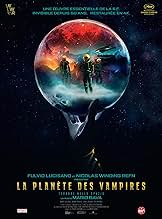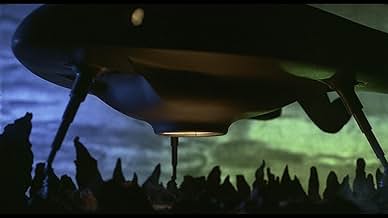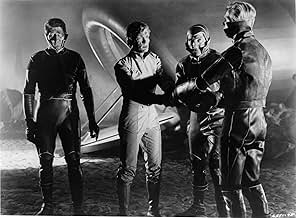NOTE IMDb
6,2/10
7,7 k
MA NOTE
Après avoir atterri sur une planète mystérieuse, une équipe d'astronautes commence à se retourner les uns contre les autres, à cause de l'influence incertaine de la planète et de ses étrange... Tout lireAprès avoir atterri sur une planète mystérieuse, une équipe d'astronautes commence à se retourner les uns contre les autres, à cause de l'influence incertaine de la planète et de ses étranges habitants.Après avoir atterri sur une planète mystérieuse, une équipe d'astronautes commence à se retourner les uns contre les autres, à cause de l'influence incertaine de la planète et de ses étranges habitants.
- Réalisation
- Scénario
- Casting principal
- Récompenses
- 1 nomination au total
Ángel Aranda
- Wess Wescant
- (as Angel Aranda)
Federico Boido
- Keir
- (as Rico Boido)
Vito Fasano
- Dead Galliott Crew Member
- (non crédité)
Giuseppe Mattei
- Brent
- (non crédité)
Avis à la une
Mario Bava does it again. The crystal colours, eerie atmosphere and evocative visuals are downright dazzling and haunting in this low-budget Italian Sci-fi outing. Never have I been disappointed in these technical aspects while experiencing the master at work. Many have mentioned it and the influences / similarities to Ridley Scott's 'Alien (1979)' ultimately sticks out. Even with that in mind it does share some ideas with the body snatcher theme, but it was a cleverly done concept done in a slow grinding, but extremely engaging style. The pacing is slow, but the flashy imagery and smoothly placed camera-work was hypnotic that it helped time flow by. My only real gripe was that the script was on the stilted side, but other than that it was one of those subtlety breezy mood pieces. More often the deaths happen off-screen and it's mostly free of action, to really only hit in the dying stages in some rapid set-pieces, but it's the dreary ending that's a strike of genius. Bava's crisp direction lets the otherworldly Gothic vibe take hold and while the sterile set designs look cheap it manages to be effective in its unusually stylish looks (add in seeping fog) and this invokes brooding unease and alienation. The surrounding sound effects and music score are creepily orchestrated. As for the special effects/make-up FX for such a low-cost production, they were well executed and ideally used. The acting can be rather rough in a staged sense with a dependable Barry Sullivan heading the way. Some of the characters were hard to tell apart though. A marvellously old-fashion, but influentially chilling space expedition.
This new release in the "MGM Midnight Movies" series of DVDs is an absolute must-have. The print of this 1965 classic is gorgeous, and for the first time since its theatrical release viewers can see the film in its original wide-screen format. For those who -- like me -- purchased the HBO Video version on VHS, don't worry: The original spare-but-effective electronic score has been restored, instead of the "updated" abomination that made the VHS print almost unwatchable.
Although I've never heard Dan O'Bannon acknowledge it, certain elements of this film must have been in his mind when he was working on "Alien": Two spaceships are drawn to an eerie, fog-shrouded planet by a mysterious radio signal, then snatched from orbit by an irresistible force. After crash landing, the surviving crew find themselves pitted against their own dead shipmates, resurrected by the parasitic mentalities of the planet, a dying race who must find a new home. There's even a scene where Barry Sullivan and Norma Bengell investigate an ancient, derelict alien spacecraft, complete with giant skeletons (any of this sound familiar?)
The set designs -- the cavernous interior of the spaceship and the appropriately alien fixtures of the derelict -- are some of the best you'll find in any pre-1968 science fiction film. Sullivan is suitably stoic as the warrior-scientist Captain; the supporting cast and in particular the luscious Ms. Bengell turn in remarkably understated performances, perfectly conveying dread verging on panic. While this movie may disappoint fans of director Mario Bava who are more familiar with his horror films, as a science fiction film buff I rate it a solid 7.
Although I've never heard Dan O'Bannon acknowledge it, certain elements of this film must have been in his mind when he was working on "Alien": Two spaceships are drawn to an eerie, fog-shrouded planet by a mysterious radio signal, then snatched from orbit by an irresistible force. After crash landing, the surviving crew find themselves pitted against their own dead shipmates, resurrected by the parasitic mentalities of the planet, a dying race who must find a new home. There's even a scene where Barry Sullivan and Norma Bengell investigate an ancient, derelict alien spacecraft, complete with giant skeletons (any of this sound familiar?)
The set designs -- the cavernous interior of the spaceship and the appropriately alien fixtures of the derelict -- are some of the best you'll find in any pre-1968 science fiction film. Sullivan is suitably stoic as the warrior-scientist Captain; the supporting cast and in particular the luscious Ms. Bengell turn in remarkably understated performances, perfectly conveying dread verging on panic. While this movie may disappoint fans of director Mario Bava who are more familiar with his horror films, as a science fiction film buff I rate it a solid 7.
The spaceships Argos commanded by Captain Mark Markary (Barry Sullivan) and her sister Galliot commanded by Captain Sallas (Massimo Righi) travel to the mysterious planet Aura to investigate a strange transmission of a distress signal. The spaceships are protected by the meteor rejector instrument but on the arrival, the gravity increases and the automatic controls go haywire and the Galliot crashes on the surface of Aura. Then the crew-members in Argos go crazy and attack each other in a first moment. Soon Captain Mark finds that most of the crew from Argos is dead after fighting against each other. When the dead members resurrect, Captain Mark, communications officer Sanya (Norma Bengell) and engineer Wess (Ángel Aranda) discover that parasite bodiless aliens have entrapped them with the transmission expecting to flee from their dying world. What will be their attitude?
"Terrore nello spazio", a.k.a. "Planet of the Vampires", despite the low- budget, is an original, stylish and with a surprising plot point. The conclusion shows a great surprise to the viewer. This movie was certainly the major influence to at least Ridley Scott's "Alien" and "Prometheus" that have similar storyline. It was said that the set was a Tower of Babel, with international cast using their own native language (Barry Sullivan, English; Norma Bengell, Portuguese; Ángel Aranda, Spanish; and Evi Marandi, English). My vote is seven.
Title (Brazil): "O Planeta dos Vampiros" ("The Planet of the Vampires")
"Terrore nello spazio", a.k.a. "Planet of the Vampires", despite the low- budget, is an original, stylish and with a surprising plot point. The conclusion shows a great surprise to the viewer. This movie was certainly the major influence to at least Ridley Scott's "Alien" and "Prometheus" that have similar storyline. It was said that the set was a Tower of Babel, with international cast using their own native language (Barry Sullivan, English; Norma Bengell, Portuguese; Ángel Aranda, Spanish; and Evi Marandi, English). My vote is seven.
Title (Brazil): "O Planeta dos Vampiros" ("The Planet of the Vampires")
In typical Bava fashion this movie has great visuals, atmosphere, and a great overall 'feel' of uneasiness. The story is very well done and ahead of it's time, and parts of it were later used (and referenced in) Alien.
Two ships land on a mysterious planet after receiving a distress call, only it turns out it wasn't in distress at all... it was a lure so they can spring a trap. The bodyless aliens turn the crew against each other so they can take over their bodies, leaving the living to wonder who's on their side and who's been taken over by the unseen enemy.
This is a great early sci-fi gem that has a great mix of horror, a mix between Star Trek and Invasion of the Body Snatchers is how this could be described. Worth a watch if you can find it.
Two ships land on a mysterious planet after receiving a distress call, only it turns out it wasn't in distress at all... it was a lure so they can spring a trap. The bodyless aliens turn the crew against each other so they can take over their bodies, leaving the living to wonder who's on their side and who's been taken over by the unseen enemy.
This is a great early sci-fi gem that has a great mix of horror, a mix between Star Trek and Invasion of the Body Snatchers is how this could be described. Worth a watch if you can find it.
I saw this film in it's 1965 American release, and at the time I was not overly impressed. It was obviously made on a low budget, the dialog dubbing is bad (although far superior to some other Italian imports I have seen), the acting alternates between wooden (Barry Sullivan) and outrageously overdone (i.e., "gravity effects", the reaction of the actor who smashes the "meteor deflector", numerous fear reaction shots of crew members). Time has proven that it has become a trend setter for numerous subsequent sci-fi films (most notably Ridley Scott's "Alien" (1979)). I recently viewed it again 37 years after it's release, and the similarities to "Alien" are unmistakable. The attentions of the crews of both films are attracted by mysterious radio signals originating from an unexplored world. The horseshoe shape of the ships in POTV resembles that of the wrecked alien spacecraft in "Alien". There are similar shots of the ship's landing gear in both films. Both crews find ancient wrecked spacecraft and skeletal remains of giant aliens on the planets they land upon. There is an unknown predatory alien presence in both films. Lots of gore footage exists in both films too, although POTV unarguably started this trend (alas, is there any recent sci-fi film that does not fall to this temptation?).I cannot believe that all these similarities are coincidental, and I suspect that Dan O'Bannon must have been heavily influenced by POTV, whether he realized it or not.
The use of lighting and color are also noteworthy. POTV still looks good today due to colorful exterior scenes (forgive the somewhat clumsy use of composite shots of the crew in a few scenes set against an obviously miniature landscape). Please also forgive the overzealous use of the zoom lens, which had just been developed at the time. One big demerit in set design comes from a scene inside the wrecked alien spacecraft. A prominently-featured prop appears to be the taillight lens from a 1957 Packard, complete with the backup light lens below it. It is positioned vertically in the shot, and perhaps the set designer was hoping that Italian audiences would not recognize it. Another detractor is the almost unlimited amount of area inside the ships. No ceilings are visible, and the various compartments look as big as football fields when compared to realistic spacecraft design criteria.
I found this to be an entertaining if somewhat flawed film, certainly more enjoyable than it was when I first watched it in 1965. It deserves a vote of 6/10.
The use of lighting and color are also noteworthy. POTV still looks good today due to colorful exterior scenes (forgive the somewhat clumsy use of composite shots of the crew in a few scenes set against an obviously miniature landscape). Please also forgive the overzealous use of the zoom lens, which had just been developed at the time. One big demerit in set design comes from a scene inside the wrecked alien spacecraft. A prominently-featured prop appears to be the taillight lens from a 1957 Packard, complete with the backup light lens below it. It is positioned vertically in the shot, and perhaps the set designer was hoping that Italian audiences would not recognize it. Another detractor is the almost unlimited amount of area inside the ships. No ceilings are visible, and the various compartments look as big as football fields when compared to realistic spacecraft design criteria.
I found this to be an entertaining if somewhat flawed film, certainly more enjoyable than it was when I first watched it in 1965. It deserves a vote of 6/10.
Le saviez-vous
- AnecdotesThis film marks the first collaboration between Mario Bava and his son/assistant director Lamberto Bava. Lamberto would later become a director himself.
- GaffesWhen Toby and Mark duke it out, Toby bumps into and moves the flight seat revealing it to be unattached to the deck.
- Citations
Capt. Mark Markary: I'll tell you this, if there 'are' any intelligent creatures on this planet... they're our enemies.
- Versions alternativesThe original Italian version runs 88 minutes long. The US version runs 86 minutes long.
- ConnexionsFeatured in Aweful Movies with Deadly Earnest: The Demon Planet (1969)
Meilleurs choix
Connectez-vous pour évaluer et suivre la liste de favoris afin de recevoir des recommandations personnalisées
Détails
- Date de sortie
- Pays d’origine
- Langues
- Aussi connu sous le nom de
- El planeta de los vampiros
- Lieux de tournage
- Sociétés de production
- Voir plus de crédits d'entreprise sur IMDbPro
Box-office
- Budget
- 200 000 $US (estimé)
- Durée1 heure 28 minutes
- Mixage
- Rapport de forme
- 1.66 : 1
Contribuer à cette page
Suggérer une modification ou ajouter du contenu manquant

Lacune principale
What is the Brazilian Portuguese language plot outline for La Planète des vampires (1965)?
Répondre



























